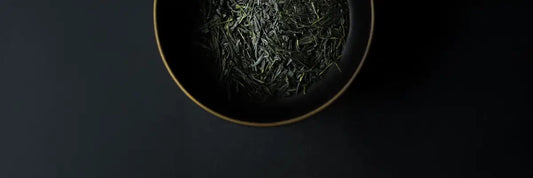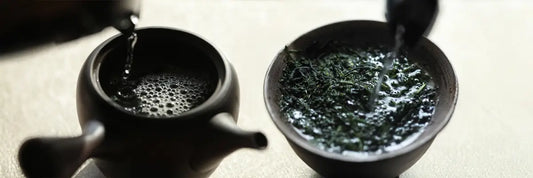There are so many similarities between gyokuro vs matcha, and only a few key differences. Although these teas look completely different, they have more in common than you might think. In this article, we are going to compare gyokuro green tea vs matcha, and see what makes them different. We’ll start with a brief overview, and then get into the specifics of gyokuro vs matcha health benefits and more.
Without further ado, let’s get started!
Gyokuro vs Matcha: Health Benefits, Popularity and Flavor
Definition
Before we compare gyokuro vs matcha, let’s start by defining both of the teas. Gyokuro, matcha and kabuse sencha are some of the most revered teas in all of Japan, but what makes them different?

Gyokuro definition
Gyokuro is a type of shaded green tea from Japan.
It differs from the standard sencha (a classic unshaded green tea) in being grown under shade rather than full sun.
The name “gyokuro” translates as “jewel dew” (or “jade dew”).
While most sencha is from the Yabukita cultivar of Camellia sinensis, gyokuro is often made from specialized varieties such as Asahi, Okumidori, Yamakai and Saemidori.
This actually creates a similarity between gyokuro vs matcha.

Matcha definition
matcha or maccha is a finely ground powder of specially grown and processed green tea leaves, traditionally consumed in Japan.
The green tea plants used for matcha are shade-grown for three to four weeks before harvest; the stems and veins are removed during processing.
During shaded growth, the plant Camellia sinensis produces more theanine and caffeine.
The powdered form of matcha is consumed differently from tea leaves or tea bags, as it is suspended in a liquid, typically water or milk.
This powdered form is the biggest difference between gyokuro vs matcha.
Production
Both matcha and gyokuro start out in similar ways.
The gyokuro plants and matcha plants are shaded for 3 weeks before the harvest in order to improve their flavor. Then, the top 3 sprouts are selected and they are gathered to be steamed. After the steaming process, you start to notice differences between gyokuro green tea vs matcha.
Matcha
If a farmer is producing matcha, they will remove the stems of the tea leaves before the next stage. These leaves, with the stems removed, are called “tencha” and they are one step away from becoming matcha.
The tencha leaves are then ground into a fine powder in a large granite mill to produce this precious ceremonial matcha powder. To learn more about the differences between tencha vs gyokuro, we recommend our article 👉 Tea Comparison between Tencha vs Gyokuro
Gyokuro
To produce gyokuro, the leaves need to be tightly rolled into these “pine needle” shapes. This requires a specialized machine and an additional phase in the production process to produce gyokuro tea.
If you want to know how matcha compares to another type of Japanese green tea called sencha, you can read this article here 👉 Matcha vs Sencha
Gyokuro vs Matcha Health Benefits
While both gyokuro tea and matcha tea are loaded with health benefits, there are a few minor differences to note between the two. An important thing to note when it comes to the differences in health benefits between gyokuro vs matcha comes down to how the teas are prepared.
Because matcha is a powdered tea, it is mixed directly into water. This means that you are consuming the entire leaf, rather than just an infusion. This has given matcha its status as the premier “healthy tea,” but a lot of this has to do with how much of the leaf you are consuming.
When you consume the entire leaf, you are getting all of the amino acids, antioxidants and vitamins contained within the leaf. This leads to the disparity between gyokuro vs matcha health benefits.
Theanine
Theanine is an amino acid that is responsible for the sweet and savory flavor of a green tea. It is also thought to have a calming effect on the brain. In green tea, the caffeine and theanine work in synergy to give you a long-lasting calm alert sensation that lasts throughout the day.
Both gyokuro and matcha are high-theanine teas, but matcha will tend to be slightly higher in theanine. Like most other differences when it comes to health benefits, the difference in gyokuro vs matcha theanine comes down to the fact that matcha is mixed directly into water and gyokuro is infused.
Benefits of drinking this tea go way beyond the delicious gyokuro taste and health benefits! There are 11 different benefits of drinking gyokuro tea. If you want to discover all of them, read our article 👉 Learn More about the Gyokuro Tea Benefits
Gyokuro vs Matcha Caffeine
Gyokuro caffeine level is considered to be among the highest, with between 120–140mg of caffeine per cup. A typical cup of matcha tea has about 68mg of caffeine per cup, but it can be much higher depending on how it’s prepared. Let’s dive into the differences between gyokuro vs matcha caffeine.
Quantity of Leaves Influences the Caffeine Level
When you are preparing gyokuro tea, you are using 5 grams of leaves and infusing it into water. When you are preparing matcha tea, you are using 2 grams of leaves, but you are mixing it directly into water. This means that gram for gram, you are getting more caffeine from matcha than from gyokuro, but because you are using more leaf, the total quantity is higher in gyokuro vs matcha.
Caffeine Is Concentrated on the Outside of the Tea Leaf
This is likely due to the fact that the caffeine is concentrated on the outside of the tea leaf. The tea plant produces caffeine as a defense mechanism to defend itself against insects. When the insects try to bite the leaf, the layer of caffeine can be incredibly bitter or even toxic. This is thought to be the reason why most of the caffeine is released in the first infusion of a leaf tea, and less of it is released in the second and third infusion.
More Matcha Powder for a Stronger Caffeine Level
When you prepare a bowl of matcha, you are getting the caffeine all at once, but there is a diminishing effect as most of it would be released in the first brewing anyway. If you want to prepare a higher-caffeine matcha tea, it’s as simple as just using more powder. When you make a cup of matcha tea with 4 grams of powder and 150ml of water, for example, you end up with a cup of tea that has 136mg of caffeine—already more than a cup of coffee.
Lower-Quality Matcha Has Less Caffeine
Just figure that each gram of premium, ceremonial-grade matcha will have ~32mg of caffeine, and work out the math from there. Lower-quality matcha will have about half the amount of caffeine, because certain stages in the production process are skipped to produce a less expensive tea.
Popularity of Matcha and Gyokuro
One of the biggest differences between matcha vs gyokuro is the difference in popularity. Matcha is probably the most well-known (albeit most misunderstood) type of Japanese green tea, while gyokuro is relatively obscure by comparison.
Powdered vs Loose Leaf Tea
One explanation for the difference in popularity likely has to do with the fact that because matcha is a powdered tea, it can be mixed into just about anything. Of course matcha lattes were an obvious innovation, but things like matcha ice cream, matcha cakes and matcha desserts soon began to take the world by storm.
Culinary Matcha Is Very Popular
Although these matcha desserts are a great way to introduce people around the world to the wonderful tea that is matcha, very few actually consume matcha in its pure form. If you really want to experience matcha tea the way it was meant to be drunk, you should try some ceremonial-grade matcha and mix it into water directly.
With all this buzz around matcha, it's no wonder that it's starting to face off against other tea stars like chai. If you’re curious how these two flavorful powerhouses stack up—from spice levels to energy boosts—you’ll love this bold face-off 👉 Chai vs Matcha: Teatime Turf War is Heating Up

Get the Right Teaware for Ceremonial Matcha
Do you want to prepare ceremonial matcha? Then you need the right teaware!
If you use the proper tools like the bamboo whisk and matcha bowl, you should be able to get a very nice thick foam on top, which will give the tea a smoother texture and consistency.
This makes the tea taste almost like a latte, but without the added milk or sugar.
What Is Gyokuro Powder?
There is such a thing as gyokuro powder. It is essentially a matcha made out of the same leaves used to make gyokuro tea. In other words, it’s made out of gyokuro instead of tencha.
On our most recent visit to see the legendary farmer Mr. Sakamoto, he proudly showed us his new matcha mills. He uses these large granite mills to grind gyokuro leaves into gyokuro matcha green tea powder. If you want to try this gyokuro matcha tea, you can find it here.
Is Gyokuro Matcha More Expensive?
Both tencha leaves and gyokuro leaves are very labor-intensive to produce, so there isn’t a major difference in price between regular matcha and gyokuro matcha.
Is Matcha Gyokuro in Powdered Form?
As we have discussed, matcha is not simply gyokuro in powdered form because it has to be made from tencha leaves. These leaves have their stems and veins removed before being ground into a fine powder. This is thought to slightly improve the flavor, color and increase the caffeine content.
By the way, if you want to learn more about the plants used to make matcha, you'll want to read this article here 👉 Meet the Matcha Plant - The Source of Matcha Green Tea




